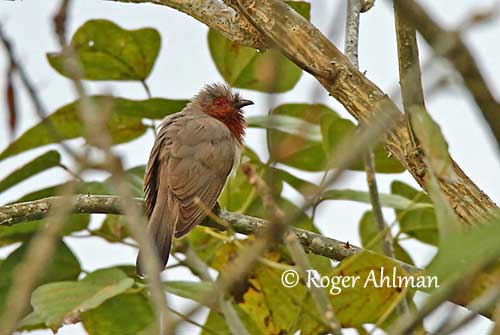
Fr: Coulicou nain - Piaye nain
Ang: Dwarf Cuckoo
All: Zwergkuckuck
Esp: Cuclillo Enano
Ita: Cuculo nano
Nd: Dwergkoekoek
Sd: dvärggök
Photographer:
Roger Ahlman
Pbase Galleries Peru and Ecuador
Text by Nicole Bouglouan
Sources:
HANDBOOK OF THE BIRDS OF THE WORLD vol 4 by Josep del Hoyo-Andrew Elliott-Jordi Sargatal - Lynx Edicions - ISBN: 8487334229
A GUIDE TO THE BIRDS OF COLOMBIA by Steven L. Hilty and William L. Brown - Princeton University Press – ISBN 069108372X
Neotropical Birds – Cornell Lab of Ornithology
THE DWARF CUCKOO IN VENEZUELA by BETSY TRENT THOMAS
Life Style of Coccyzus pumilus, a Tropical Cuckoo by Carol Pearson Ralph
EcuRed – Conocimiento con todos y para todos
Dwarf Cuckoo
Coccycua pumila
Cuculiformes Order – Cuculidae Family
INTRODUCTION:
The Dwarf Cuckoo is now in the genus Coccycua that includes the smallest species of the subfamily Coccyzinae in the large family Cuculidae. This species occurs in N South America where it frequents tropical and subtropical forests. It is found in Brazil, Colombia and Venezuela. However, recent records indicate that the Dwarf Cuckoo is also present in Ecuador.
This species is not a brood parasite. It builds its own nest and rears its chicks.
The Dwarf Cuckoo is fairly common throughout the range.

DESCRIPTION OF THE BIRD:
Biometrics:
Length: 21 cm
Weight: 36 g
The Dwarf Cuckoo is a small bird with brownish-grey upperparts including head, wings and tail. The rectrices show black subterminal band and narrow white tips. The tail is more rounded than graduated.
On the underparts, chin, lower face, head sides, throat and upper breast are rufous, and contrast strongly with the buffy-white belly. Flanks and underwing-coverts are mostly buffy.
The bill is black with arched culmen. The eyes are red, surrounded by red eyering. Legs and feet are black.
Male and female are similar.
The juvenile is light brown above but it has pale grey throat. The eyes are brown with yellow eyering.

RANGE:
The Dwarf Cuckoo is found in Colombia, mainly on E slopes of the Andes, and through upper Orinoco valley to NE Venezuela. The species was recorded in N Brazil (Roraima) and since December 2012 in Ecuador, and more recently in Las Peñas, Esmeraldas.
HABITAT:
The Dwarf Cuckoo is relatively common locally in gallery forest, shrubby pastures or pastures with scattered trees, deciduous and secondary forests, open woodland, parks and gardens.
The Dwarf Cuckoo often prefers drier areas, but recently, it has been observed in more humid and wet areas in forest clearings.
This species occurs from sea-level up to 1000 metres of elevation, and up to 2600 metres near Bogotá in Colombia.
CALLS AND SONGS: SOUNDS BY XENO-CANTO
The Dwarf Cuckoo’s call is a “churr” or “trrr trrr trrr…”
The dawn song is a “kööa kööa”.

BEHAVIOUR IN THE WILD:
The Dwarf Cuckoo feeds mainly on caterpillars, and like the cuckoos of genus Coccyzus, it sheds periodically the stomach lining. It also feeds on various insects such as treehopper nymphs of family Membracidae (Hymenoptera) and moths.
The prey items are found in trees and shrubs by slowly peering about in tree branches. It even drops to the ground for feeding, but it remains near the vegetal cover. It is usually solitary.
During the breeding season, the Dwarf Cuckoo is monogamous, but polyandrous mating is reported, with females mating with two males, and both males take part in chick rearing.
The Dwarf Cuckoo male also performs courtship feeding during all the nesting cycle. From an observation in Venezuela, an adult male was observed with a large moth in its bill. An adult female joined it on a small branch. The birds perched close to each other and engaged in a tug-of-war while each one alternately pulled the moth. After leaving the prey, both birds flew to a higher perch and copulation occurred. The female still held the insect’s body in her bill while mating. When they separated, the male was still holding the moth but the female stole it from him and tried to eat it.
This observation confirms the courtship feeding behaviour. (Betsy Trent Thomas)
The Dwarf Cuckoo is usually resident, at least in Colombia where the birds remain on their territories all year round. However, seasonal movements are reported in Venezuela savanna, closely related to the rains.
The Dwarf Cuckoo has mainly a gliding flight through the forest.

REPRODUCTION OF THIS SPECIES:
The Dwarf Cuckoo is not a brood parasite. It may breed all year round.
It builds a flimsy platform with twigs, tendrils and leaves, between 1 and 7 metres above the ground in the canopy of small tree. The nest-site is strongly defended against intruders.
The female lays 2-3 whitish eggs. Sometimes, two females may lay in the same nest. The incubation starts with the first egg laid, and is shared by both adults. The chicks are fed by their parents and leave the nest between 4 and 11 days after hatching. They fledge at 12 days old.
When a female mates with two males, they take part in nesting duties.
PROTECTION / THREATS / STATUS:
The Dwarf Cuckoo is fairly common throughout the range. Unlike numerous bird species, it benefits from habitat degradation that creates new suitable areas.
The population size has not been quantified, but it is suspected to be increasing.
The Dwarf Cuckoo is currently evaluated as Least Concern.
